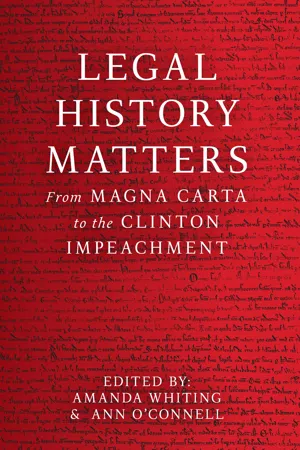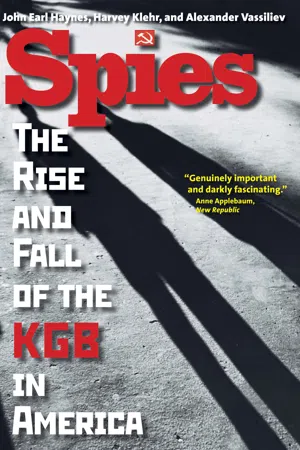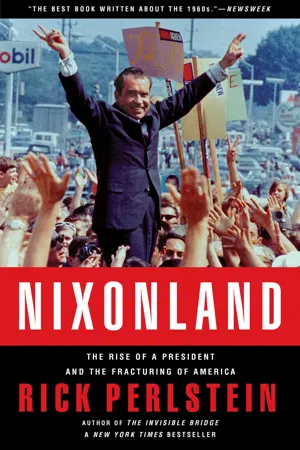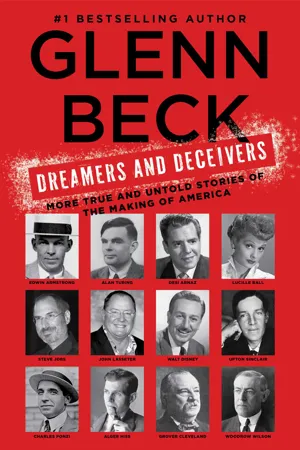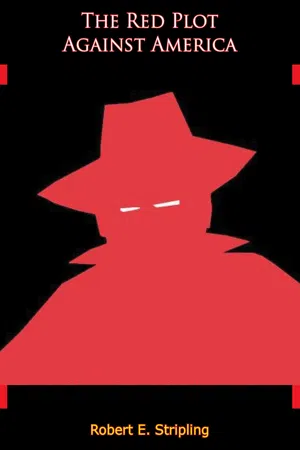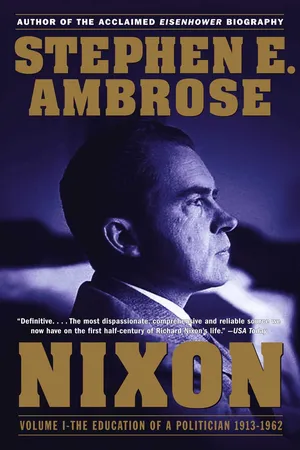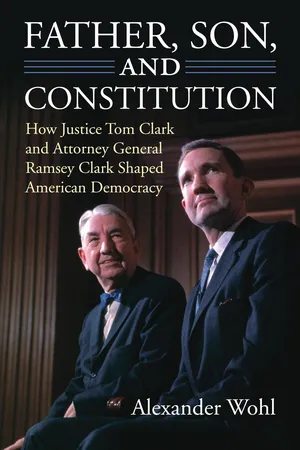History
Alger Hiss
Alger Hiss was an American government official who became embroiled in controversy during the Cold War era. He was accused of being a Soviet spy, which led to a highly publicized trial and his eventual conviction for perjury. The case against Hiss became a symbol of the ideological struggle between the United States and the Soviet Union.
Written by Perlego with AI-assistance
Related key terms
Related key terms
1 of 4
Related key terms
1 of 3
8 Key excerpts on "Alger Hiss"
- eBook - ePub
Legal History Matters
From Magna Carta to the Clinton Impeachment
- Amanda Whiting, Ann O'Connell(Authors)
- 2020(Publication Date)
- Melbourne University Press Digital(Publisher)
1 His career was brought to a sharp end when he was accused of being a member of a secret ring of communists who had infiltrated the US Government during the 1930s and 1940s. Hiss’ trial was a landmark moment in post-war American history. It was the political making of Richard Nixon, then a little-known congressman from California, and was seized upon by Senator Joseph McCarthy as evidence that the Roosevelt and Truman administrations, and the New Deal institutions created and reinforced under their tenure, had been infiltrated by Soviet agents and communist sympathisers. This chapter attempts to evaluate why this remained the case. It focuses on three distinct aspects of the Hiss case that make it unique and noteworthy, even by the standards of the era. It argues that Alger Hiss, due to his role as an advisor to Roosevelt, was used as a convenient cipher through which to attack the entire New Deal project as socialism by stealth, tarring liberalism with the brush of treason. However, the Hiss case was so significant because, unlike any such event before it in American history, anyone with access to a television was capable of watching Hiss and his accuser, Whittaker Chambers, testify in what essentially amounted to a quasi-trial before Congress, and judging for themselves whether Hiss was guilty. Finally, it assesses how Hiss’ case has reverberated throughout history, and the parallels between the Hiss affair and contemporary American politics.Alger Hiss was one of a myriad number of Americans who were accused of being either spies, or, at the very least, sympathisers to the Soviet Union during the Second Red Scare.2 While others were actors,3 playwrights4 and intellectuals,5 Alger Hiss stood out, in part because of his background. Hiss was born to a family of New England blue-bloods, but grew up in Baltimore, where he graduated from high school and attended Johns Hopkins University, before completing a law degree at Harvard Law School.6 He was chosen for one of the most prestigious graduate positions an American law student could obtain; a clerkship with a Justice of the Supreme Court—in Hiss’ case, the legendary American jurist Oliver Wendell Holmes.7 In short, Hiss was the epitome of upper-class American success.Beyond this, however, the accusations against Hiss took on a special meaning because of his role advising President Franklin Roosevelt towards the end of World War II, and playing a key part in the establishment of the post-war global order. In famous photographs of the ‘Big Three’ at the Yalta Conference—Roosevelt, Joseph Stalin and Winston Churchill—Hiss is visible in the background, having served as a senior aide during the conference.8 He accompanied the President to a number of the conferences which helped set out the post-war world order that followed, and, most notably, chaired the San Francisco Conference that would draft the UN Charter.9 The new global institutions that sprang up following the end of World War II—the United Nations, the World Bank and the International Monetary Fund, among others—were created out of the work of people like Hiss. Thus, when Hiss and other prominent New Dealers and Roosevelt appointees were implicated in charges of disloyalty to the United States, this provided an opportunity for the entire liberal establishment to be then branded with this same label. As Lesley Fiedler wrote in 1951 after Hiss’ imprisonment, Hiss’ history was that of the ‘prototypical…New Dealer’, and it was not so much Hiss that was on trial but rather an entire generation of liberals.10 - eBook - ePub
Spies
The Rise and Fall of the KGB in America
- John Earl Haynes, Harvey Klehr, Alexander Vassiliev, Philip Redko(Authors)
- 2009(Publication Date)
- Yale University Press(Publisher)
CHAPTER 1
Alger Hiss
Case Closed
A lexander Vassiliev’s notebooks quote KGB reports and cables from the mid-1930s to 1950 that document KGB knowledge of and contacts with Alger Hiss and unequivocally identify Hiss as a long-term espionage source of the KGB’s sister agency, GRU, Soviet military intelligence. Hiss is identified by his real name as well as by cover names, “Jurist,” “Ales,” and “Leonard.” The material fully corroborates the testimony and accounts of Whittaker Chambers, Hede Massing, Noel Field, and others, while offering new details about Hiss’s relationship with Soviet intelligence.No individual is a more potent symbol of American collaboration with Soviet intelligence than Alger Hiss. From the moment of his confrontation with Whittaker Chambers in 1948, Hiss became the central figure in a debate that has divided Americans for decades. On the one side stood those who saw him as the archetype of a generation of young, college-educated people radicalized by the Depression, drawn to Washington during the heady days of the New Deal, and ultimately converted to communism. Intoxicated by their new ideology, they cooperated with Soviet intelligence agencies and eventually betrayed liberalism’s commitment to political democracy and aided Stalin’s totalitarian state. On the other side are those who regarded Hiss as an innocent victim of anti-Communist paranoia, a New Deal idealist maliciously framed by right-wing provocateurs backed by the reactionary wing of the Republican Party and malign elements of the FBI who were eager to discredit liberalism and taint the New Deal and the Democratic Party with treason.1The Hiss-Chambers case riveted the nation as it moved from the halls of Congress to the federal courtroom, where Hiss was convicted of perjury for lying about providing government secrets to Chambers, a self-confessed Soviet agent handler. Not only was Hiss a seeming model of the New Deal establishment—elite prep school, Johns Hopkins University, Harvard Law School, protégé of Felix Frankfurter, law clerk to Oliver Wendell Holmes, and president of the Carnegie Foundation for International Peace—but he also had occupied important posts in the government, rising from an obscure lawyer for the Agricultural Adjustment Administration (AAA) to become a senior diplomat, director of the State Department’s Office of Special Political Affairs, attending the 1945 three-power Yalta Conference as an adviser to President Roosevelt, and presiding at the founding conference of the United Nations. In addition to these achievements, he was an elegant, handsome, charming, and distinguished-looking man. - eBook - ePub
Betrayals And Treason
Violations Of Trust And Loyalty
- Nachman Ben-yehuda(Author)
- 2018(Publication Date)
- Routledge(Publisher)
33Alger Hiss was born in 1904 in Baltimore and developed an impressive career in different departments of the U.S. administration. In 1936 he entered the State Department where he served in some key roles, including advising President Roosevelt during the Yalta Conference (February 4-11, 1945). Hiss quietly left the State Department to become the president of the Carnegie Endowment for International Peace in 1947. Following Chambers's statement in 1948, Hiss denied the charges and sued Chambers for libel. One member of the committee, Republican Richard M. Nixon, accused Hiss of lying and convinced Chambers to reveal some evidence he supposedly had against Hiss. Hiss continuously claimed that he was not a spy. The accusations made by Chambers and the denials and counteraccusations made by Hiss helped to produce two trials. Under the statute of limitations, Hiss could not be tried for espionage, and he was therefore indicted on two counts of perjury. In his first trial, in July 1949, the jurors could not come to a decision. Hiss's second trial began in November 1949. He was convicted on January 21, 1950, and sentenced to five years in prison (he actually served forty-four months).For many years, the question of whether Hiss was really a spy haunted America.34 As Polmar and Allen (1997) point out, this puzzling case was solved in the 1990s. First, in 1992 General Dmitri Volkogonov, a Russian historian in charge of the KGB and military intelligence archives, revealed that he had searched the relevant files, found nothing, and that therefore the accusations against Hiss had been "completely groundless."35 However, Volkogonov admitted that he "could not rule out the possibility that some records had been overlooked or even destroyed."36 Second, in 1993 a Hungarian historian doing research on the Hungarian secret police—Maria Schmidt—stated that she had discovered documents that indicated that Mr. Hiss was a Communist spy.37 However, the most credible evidence was produced in 1996, the same year in which Hiss died. In that year, decrypted Soviet intelligence messages (code name "Venona") from the 1940s were released by the NSA (National Security Agency) and linked Hiss directly to espionage.38 Specifically, one document, dated March 30, 1945, identified a Soviet spy in America code-named "Ales." The message identified "Ales" as working in the State Department and as the person who accompanied President Roosevelt to the 1945 Yalta Conference and then flew on to Moscow. There, "Ales" met Andrei Vyshinsky, then Soviet Commissar for Foreign Affairs, and was cited for his aid to the Soviets. We know that Hiss worked at the time of the Yalta Conference in the State Department and that he accompanied President Roosevelt to the Yalta Conference as an adviser.39 Hiss himself admitted that he spent a night in Moscow after the Yalta Conference, but he denied that he was Ales. His version was that he went to Moscow to see the subway system.40 - eBook - ePub
Nixonland
The Rise of a President and the Fracturing of America
- Rick Perlstein(Author)
- 2008(Publication Date)
- Scribner(Publisher)
The story that began with an odd and lumbering Columbia University undergraduate named Whittaker Chambers receiving the holy orders of Communist Party membership in 1925, and reached its peak in the late forties in a tale of safe houses, pilfered microfilm, hidden compartments, and mysterious suicides (or were they murders?), was a spy story with the trappings of Cold War grand opera. “I have testified against him with remorse and pity” went a typically melodramatic Whittaker Chambers pronouncement about Alger Hiss, the man he claimed had once been his best friend. “But in a moment of historical jeopardy in which this nation now stands, so help me God, I could not do otherwise.”Once upon a time Whittaker Chambers dedicated his life to running an underground spying apparatus for the only cause he believed could redeem a hopelessly fallen world. Alger Hiss, one of the foreign policy establishment’s glamour boys, was an accomplice. A paranoid and an apocalyptic, Chambers took a precaution: during his last months as a Red spy, he kept some of the intelligence Alger Hiss had stolen from the State Department and hid it in a safe place. In case Chambers died under mysterious circumstances, it could be proven a murder. Later, when Chambers switched sides and became an anticommunist, he kept the documents: they now could serve duty in the event of a final showdown between East and West by convincing the spineless middle classes how the enemies of freedom were preparing to destroy them.Ten years passed. Chambers established a quiet career as a man of letters. Hiss continued his ascent up the slopes of the Establishment. Then, in 1948, Harry Truman called Congress back from its summer recess to deal with inflation and got more than he bargained for. The House Un-American Activities Committee maneuvered, characteristically, to steal the limelight, calling hearings on espionage to piggyback on a New York grand jury’s recent indictment of twelve Communist leaders based on the testimony of Elizabeth Bentley, whom the New York World-Telegram racily labeled a “beautiful blonde.” She was actually a homely brunette. But a sense of sexualized menace was a common currency of voyeuristic tabloids and voyeuristic congressional committees at the high tide of the Cold War.Few expected anything substantial to come from HUAC, then or ever. Some of its members were so dumb that they couldn’t follow the proceedings. Others compulsively interrupted to compare Communism to venereal disease—or, in the case of Mississippi’s John Rankin, to fulminate against the Jewish Communists in the ancient Levant who crucified Christ. The worst thing about HUAC, to some who took anticommunism seriously, was that it was ineffectual in building cases for the prosecution of actual Communists. - eBook - ePub
Dreamers and Deceivers
True Stories of the Heroes and Villains Who Made America
- Glenn Beck(Author)
- 2014(Publication Date)
- Threshold Editions(Publisher)
8
The Spy Who Turned to a Pumpkin: Alger Hiss and the Liberal Establishment That Defended a Traitor
I had attacked an intellectual and a liberal. A whole generation felt itself on trial. —Whittaker Chambers Yalta, Soviet Union February 4, 1945While the barrel-shaped British prime minister droned on, the American diplomat stole glances at the magnificent view outside the windows. The Black Sea looked menacing and cold from the warmth of Livadia Palace. With antique mirrors, crystal chandeliers, and the finest in Soviet hospitality, the palace was a grand setting. The American figured it was the perfect place for leaders seeking to carve up the world to meet. It was here, he recalled, where the last Russian czar and his family enjoyed many summers, basking in their decadence while their people starved. At least until Soviet communists rose up and conquered them.The Soviets were now using the same apartments in the same decadent palace for themselves. That irony did not even cross the mind of the forty-year-old American diplomat, Alger Hiss, who viewed the communist leadership as a force for good.The three titans of the world—Winston Churchill, Joseph Stalin, and Franklin D. Roosevelt—along with their respective military brass and diplomatic corps, had cause to celebrate. After five years of grinding war, it was finally coming to an end. The fascists were all but defeated. The only question left was how to divide up the spoils.“These are among the most important days that any of us shall live,” Prime Minister Winston Churchill thundered. Hiss rolled his eyes. It wasn’t even noon and he was convinced that Churchill had already downed one too many Johnnie Walkers. He had a penchant for grandeur, hyperbole, and self-importance. Someone ought to just tell the senile old man he was losing his empire.Then it was the Soviet leader’s turn. Hiss fixed his eyes on the commanding presence of the mustachioed Stalin. It was the first time he had been in a room with the powerful Soviet leader, and he wasn’t disappointed. Stalin had nearly ended his monologue, which had been accentuated by the loud pounding of his fist on the table, when the English translation began: - eBook - ePub
- Robert E. Stripling, Bob Considine(Authors)
- 2017(Publication Date)
- Muriwai Books(Publisher)
CHAPTER 11 — Alger Hiss
THE FIRST telegram the House Un-American Activities Committee received, after Whittaker Chambers had testified about a pre-war Communist spy ring in Washington, was sent by the most prominent man Chambers named as an accomplice.“My attention (it read) has been called by representatives of the press to statements made about me before your Committee this morning by one Whittaker Chambers. “I do not know Mr. Chambers and insofar as I am aware have never laid eyes on him. There is no basis for the statements made about me to your Committee.“I would appreciate it if you would make this telegram a part of your Committee’s record, and I would further appreciate the opportunity to appear before your Committee to make these statements formally and under oath. I shall be in Washington on Thursday and hope that that will be a convenient time from the Committee’s point of view for me to appear.”It was from Alger Hiss, brilliant young president of the Carnegie Foundation for International Peace.We received it on the night of Tuesday, August 3, 1948. But inasmuch as Hiss could not appear until the fifth of the month, we heard Nathan Gregory Silvermaster in the interim. Silvermaster had been named by ex-Communist Elizabeth Bentley as a member of the Russian secret police, leader of one of the spy rings working in Washington during the war, but also a $9,000-a-year Government official.Silvermaster is a slight, middle-aged man with a shock of blond hair and a toothbrush mustache. He was born in Odessa, Russia, came to this country in 1915, entered the Government in 1935 with the Resettlement Administration, moved to the Maritime Labor Board as chief economist, thence to the Labor Division of the Farm Security Administration as its director.In 1941 he was loaned briefly to the Board of Economic Warfare. In 1944, after his Labor Division at the Foreign Economic Administration folded, he moved on to the Office of Surplus Property, Consumer Goods Division, Treasury Department, then to the post of chief economist and director of the Department’s Market Research Division. Finally he wound up with RFC. En route he helped Assistant Secretary of Treasury Harry Dexter White draw up the Bretton Woods Agreement. - eBook - ePub
Nixon Volume I
The Education of a Politician 1913-1962
- Stephen E. Ambrose(Author)
- 2014(Publication Date)
- Simon & Schuster(Publisher)
CHAPTER TENTHE HISS CASEAugust–December 1948
BECAUSE OF THE complexity of the Alger Hiss case, the emotions it aroused, the personalities of the principal characters involved, and its importance, entire shelves in the stacks of large libraries are filled with books on the subject. Small details have become the subject of big books. Four decades after the case, monographs continue to appear, “proving” this case or that, about Hiss’s typewriter, or his car, or his CP involvement. It is almost the American Dreyfus affair. It stamped forever and obsessed the lives of those most directly involved—both the accused, Alger Hiss, and the accuser, Whittaker Chambers. Nixon used it more positively, as a springboard to the Senate and then the Vice-Presidency. But as the Watergate tapes indicate, there were elements of obsession even in his reaction. In the conversations the tapes recorded, President Nixon referred again and again to the Hiss case, which by then was a quarter century in the past.1Summer 1948. President Harry S. Truman had been renominated, reluctantly, by the Democrats; Governor Thomas E. Dewey of New York was the Republican nominee. Although active campaigning would not begin until Labor Day, both parties were intent on using the last days of the congressional session—a special session, called by Truman to embarrass the Republicans (he dared them to pass the legislation they had called for in their party platform)—to create favorable campaign issues.HUAC, for its part, wanted to raise the issue of Communist infiltration into the government. The Truman Administration let it be known that in the event of a Democratic victory in November it would abolish the committee. Thus the hearings that began on July 31 were the most crucial in HUAC’s long and controversial career, because the very existence of the committee was at stake. What HUAC knew, thanks to Nixon’s contacts with Father Cronin and to Robert Stripling’s investigations, and what the Administration wanted to downplay or ignore, was that a number of ex-Communists, including Elizabeth Bentley (dubbed the “Red Spy Queen” by the press) and Whittaker Chambers, had told the FBI and other authorities of the existence of a Communist cell inside the government, but nothing had been done about it. To Nixon this inaction proved that either the Truman Administration was criminally lax in its security procedures or was shot through with traitors. To prove that thesis, however, he first had to prove that the cell actually existed. - eBook - ePub
Father, Son, and Constitution
How Justice Tom Clark and Attorney General Ramsey Clark Shaped American Democracy
- Alexander Wohl(Author)
- 2013(Publication Date)
- University Press of Kansas(Publisher)
37The Alger Hiss CaseThree other cases involving espionage allegations against government officials would also involve Clark and lead to criticism of his department for its purported failure to pursue them. These were the cases of Judith Coplon, a political analyst at the Justice Department; Harry Dexter White, a prominent economist and Treasury Department official who played a key role in establishing the International Monetary Fund; and Alger Hiss, a former State Department official and Roosevelt aide who played a vital role in creating the United Nations during his involvement in the Yalta Conference. Of all the government spy cases he was involved in, perhaps the most personally troubling to Clark was the one involving Coplon.A member of the Young Communist League while a scholarship student at Barnard, Judith Coplon graduated with honors in 1943 and was hired by the Justice Department the following year in the “economic warfare section.” She was identified as a spy in part through intercepted Soviet cables. Clark and Hoover wanted to dismiss her and thereby avoid additional bad press. (Her file included a promotion letter praising her work and signed by Clark.) But the department decided to pursue the case in order to find her Soviet contact. Agents set up wiretaps and surveillance of her apartment and fed her phony documents. Coplon was arrested with her Soviet contact (and claimed lover) with several secret documents, including the planted, faked ones. Not surprisingly, Republicans, led by HUAC and Richard Nixon, attacked the Truman administration, questioning how much “we can trust the opinions of administrators in the Executive Branch when the Justice Department itself is infiltrated.”38
Index pages curate the most relevant extracts from our library of academic textbooks. They’ve been created using an in-house natural language model (NLM), each adding context and meaning to key research topics.
Explore more topic indexes
Explore more topic indexes
1 of 6
Explore more topic indexes
1 of 4
